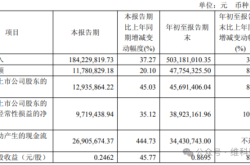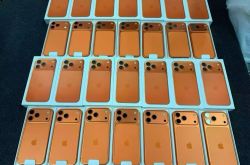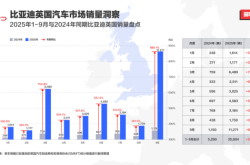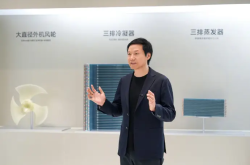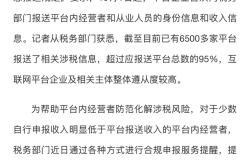Midea Leads the Pack: Navigating the Humanoid Robot Market
![]() 03/27 2025
03/27 2025
![]() 682
682
Text/Dou Wenxue
Editor/Ziye
A decade ago, Midea envisioned robots as an extension of its 'Double Intelligence' strategy, encompassing Smart Home and Smart Manufacturing. Today, Midea continues to advance in this direction.
On March 18, during the China Appliance and Electronics Expo, Midea unveiled its prototype humanoid robot.
Media reports and videos released by Midea's official account reveal that this humanoid robot can perform actions like shaking hands, making heart shapes, dancing, and screwing. It also understands voice commands, interacts with people, and completes tasks as instructed.
Midea Humanoid Robot, image source: Midea's official WeChat video account
The unveiling of this robot garnered significant industry attention, with the capital market reacting swiftly. Both Midea Group's A-shares and H-shares surged. By the close of trading that day, Midea's A-share price had reached 74.98 yuan/share, up 4.31%, while its H-share price stood at 80.2 Hong Kong dollars/share, an increase of over 10%.
The capital market's enthusiasm likely stems from the potential this humanoid robot showcases for Midea's business expansion.
Last October, Midea officially announced its development of core components for humanoid robots, a key strength in its research and development efforts.
Since 2015, Midea has explored the robotics sector through mergers, acquisitions, and collaborations, achieving initial success in industrial robot R&D. While Midea has experience in robot bodies and components, its humanoid robot R&D history is relatively short.
Within six months, Midea has showcased a prototype humanoid robot with basic voice interaction capabilities, demonstrating rapid progress in humanoid robot manufacturing and R&D.
Recently, on February 5, Fang Hongbo, Chairman and CEO of Midea Group, revealed that the company's robotics and automation segment revenue exceeded 30 billion yuan.
The robotics business is a crucial part of Midea's three major ToB businesses, presenting significant growth potential.
1. What Sets Midea's Humanoid Robot Apart?
The humanoid robot wave surged in 2024, with technology companies like Tesla, 1X, and FigureAI entering the sector. During this year's Spring Festival Gala, Unitree Robotics' humanoid robot gained popularity, attracting widespread attention.
Home appliance brands like Midea have also entered the market. For instance, Haier Smart Home collaborated with LEJU Robotics to launch a service-oriented humanoid robot, and Sichuan Changhong commenced trial production of its first humanoid robot in July 2024.
According to hard technology industry research predictions, 2025 will be the first year of mass production in the humanoid robot field, with 2026 expected to witness a commercialization explosion.
Midea is driving the transformation of humanoid robots from niche to mass market. In October 2024, it announced its entry into the humanoid robot market and subsequently exhibited a voice-command-capable humanoid robot.
Midea plans to apply its prototype in its factories. There are two versions: gray and white. The gray version will be deployed at Midea's Washing Machine factory in Jingzhou next month, while the white version will be used for household chores in combination with white goods, with specific scenarios still under development.
In the manufacturing industry, the term 'robot' is familiar. Most enterprises, including Midea, are involved in industrial robots. Some have deployed self-developed industrial robots in factories, while others have achieved commercialization.
In 2017, Midea acquired Kuka, one of the world's four largest industrial robot companies. Since 2021, Kuka has overcome performance declines and achieved stable growth.
In 2021, Kuka's sales revenue increased by 30.9% year-on-year, with outstanding performance in the Chinese market, where sales revenue surged by 97.2%. In 2023, both Kuka Group's revenue and profitability reached record highs, with Kuka China's revenue contribution increasing from 15% in 2020 to over 22% in 2022.
Fang Hongbo previously disclosed that Kuka has established a fully automated production line where robots produce robots, operating 24/7 with an average production time of one robot every 30 minutes.
Image source: Midea's official website
Midea's long-term investment in industrial robots gives it a competitive edge in component R&D and supply chain management for humanoid robots.
Midea's ability to quickly manufacture a complete humanoid robot is based on its expertise in industrial robot core component R&D.
Midea also has financial and scenario advantages for humanoid robot R&D. Its real home appliance industrial manufacturing scenarios and vast production data can accelerate humanoid robot training and progress.
However, humanoid robots have different technical requirements and application scenarios from industrial robots, where Kuka excels. Midea still needs to continue exploring this area.
Wei Chang has stated, 'Making complete humanoid robots is not difficult. The challenge lies in solving user pain points and achieving true application. There is no specific timetable yet, and we are deeply exploring application scenarios.'
This conservative response underscores the core of humanoid robot R&D. Midea has a long way to go before humanoid robot commercialization.
2. Why Does Midea Prioritize Robots?
Midea has been involved in robotics for 10 years.
In 2013, after the 'home appliances going to the countryside' policy waned and the domestic appliance market became saturated, Midea sought new avenues beyond home appliances.
In 2015, Midea set its transformation goals. As Fang Hongbo stated in an internal letter, 'Midea's boundaries will blur. We strive to transform from a traditional home appliance enterprise to an intelligent hardware company with Internet thinking.'
Subsequently, the robotics industry became a 'trial water' direction for Midea, which invested heavily in acquiring or investing in robotics companies.
In August 2015, Midea established two robot joint ventures with Yaskawa Electric of Japan and acquired a 5.4% stake in Kuka Robotics, a German robot giant and one of the 'Big Four' in robotics.
In early 2016, Midea invested 178 million yuan to acquire a 17.8% stake in a Chinese industrial robotics enterprise. In June, it launched a 3.7 billion euro acquisition offer for Kuka, completed in early 2017. Additionally, Midea acquired Israel's High-Tech in 2017 to further build its robotics and automation system segment.
In 2022, Midea completed the 100% acquisition of Kuka, achieving privatization.
From initial trials to substantial acquisitions and equity investments, Midea found the robotics industry's development direction: solving upstream technology 'choking points' and deploying in the industrial robot supply chain.
Taking harmonic reducers, a core industrial robot component, as an example, Midea began R&D in 2019, achieved mass production in 2022, and obtained 'internationally advanced' certification. In the same year, Midea's harmonic reducers passed industry standard durability tests.
In 2023, Midea's high-performance harmonic reducers received the 'Leaderobot 2023 Annual Robot Reducer Technology Breakthrough Award'.
Investment and technological R&D breakthroughs have made Midea a 'chain leader' in the robotics industry. Fang Hongbo stated that the Kuka Smart Manufacturing Science and Technology Park has attracted multiple core component enterprises, such as servo motors, drives, and controllers, with a supply chain supporting rate of over 85%, reducing logistics costs and improving efficiency.
Midea also disclosed in its H-share prospectus that it hoped to spin off its Meizhi Photoelectricity, robotics, and automation system businesses within three years after listing.
The planned spin-off indicates that Midea sees new growth opportunities in its robotics and automation system-related businesses.
Besides technological investments in the supply chain, Midea explores more robot application scenarios and seeks B-end partners for its robotics business.
For example, Kuka's AMR (Automated Guided Vehicle) is designed for factory logistics and warehousing. In welding technology, Kuka's robots achieve precise welding through laser tracking systems.
Furthermore, Kuka has developed the SCARA series of robots applicable in lithium batteries and electronics. These products are used in multiple lithium battery cell production and assembly links and in 3C electronics handling, assembly, inspection, and clean production workshops.
Now, Midea, which has entered the humanoid robot field, will also explore B-end and C-end application scenarios.
Wei Chang said in an interview, 'Midea's robots are divided into two categories: robotization of home appliances, integrating humanoid technology like vision, robotic arms, and human-computer interaction; and development of complete humanoid robots, exploring B-end application scenarios.'
Judging from Midea's current robotics efforts, B-end landing exploration may progress faster, adding momentum to its ToB business.
3. Midea's ToB Business: The Second Growth Curve
Midea's official website showcases a diverse business portfolio, including smart homes, new energy and industrial technology, smart building technology, robotics and automation, healthcare, and smart logistics.
In other words, Midea has established a business matrix focusing on both smart home (ToC) and commercial/industrial solutions (ToB).
While ToC business remains Midea's core, the home appliance industry has entered a stock competition stage after years of rapid growth.
According to AVC Revo data, in 2023, China's home appliance retail market (excluding 3C products) was worth 849.8 billion yuan, with a year-on-year increase of only 3.6%.
However, the ToB business, encompassing building technology, industrial technology, and robotics and automation, has vast market potential. Midea's customer base now includes enterprises across various industries.
Midea's core technologies in compressors, motors, variable frequency control, and other fields are applicable not only to home appliances but also to B-end fields like industrial equipment, new energy, automobiles, and energy storage.
In recent years, Midea's ToB business revenue proportion has gradually increased, from 18.5% in 2020 to over 26% in 2023.
Today, Midea's ToB business imagination is richer than ever.
For instance, the robotics and automation segment, where humanoid robots reside, may bring new growth to Midea, both technologically and in terms of current market demand.
Technologically, humanoid robots are the pinnacle of robotics, requiring human shape, movement, and communication simulation, involving complex bionics, dynamics, high-precision speech recognition, natural language processing, and strong learning and autonomous decision-making abilities.
This necessitates continuous technological exploration by Midea, which has begun to chase the AI wave, launching its 'Meiyan large model' and integrating OpenAI and DeepSeek large models into its products.
Additionally, Midea has accumulated partners across multiple industries. Since 2024, it has collaborated with Volkswagen, BOOSTER Precision Components GmbH, NIO, and Yawei in industrial robots.
As of June 2024, Midea's robot density exceeded 620 units/10,000 people, a significant increase from 570 units/10,000 people at the end of 2023.
Apart from robotics and automation, Midea's other two ToB businesses have also achieved substantial progress in phases.
From a performance standpoint, Midea's new energy and industrial technology business, along with its smart building technology business, generated revenues of RMB 25.4 billion and RMB 22.4 billion, respectively, both showing year-on-year growth of 19% and 6%.
Particularly, Midea's building technology business offers enterprises smart building solutions. For instance, in Midea's 08 Space, its R&D achievements cater to various daily office scenarios. Employees can utilize relevant apps to reserve meeting rooms, and through facial recognition, the system automatically logs floor information, dispatches elevators, and adjusts meeting room air conditioning, lighting, and conference tablets, among other features.
As of the end of 2024, Midea's building technology has forged collaborations with enterprises and organizations such as Maydos, Laoxiangji, and Glodon, showcasing remarkable delivery capabilities in sectors including commerce, industry, transportation, and healthcare, as well as in efficient data centers, energy-saving renovations, and infrastructure development.
Image source: Midea's official website
In the realm of industrial technology, Midea's operations span consumer appliances, industrial automation, photovoltaic energy storage, smart transportation, and more.
Within this technical domain, Midea Group boasts brands like High-Tech, Hefcon, and Riye, which provide solutions encompassing the sensing layer to the control layer for clients in process industries, hybrid industries, and discrete industries.
Currently, this business segment is emerging as a growth driver for Midea. Taking Hefcon New Energy as an example, in the first three quarters of 2024, the company witnessed a remarkable 213.64% increase in revenue, with its net profit turning from negative to positive, up 169.92% year-on-year.
Overall, Midea Group's B-end business is evolving into a significant contributor to the group's operating revenue.
Recently, Midea has unveiled a prototype humanoid robot and announced the establishment of a humanoid robot innovation center. Riding on the wave of the robot trend, the market may become increasingly optimistic about Midea's future prospects.
If Midea can expedite the deployment of humanoid robots, it will inch closer to becoming an 'intelligent hardware company with Internet thinking'. In the future, the spin-off and listing of this business segment are poised to garner favorable responses from the capital market.
(The lead image of this article is sourced from Midea Group's official website.)

